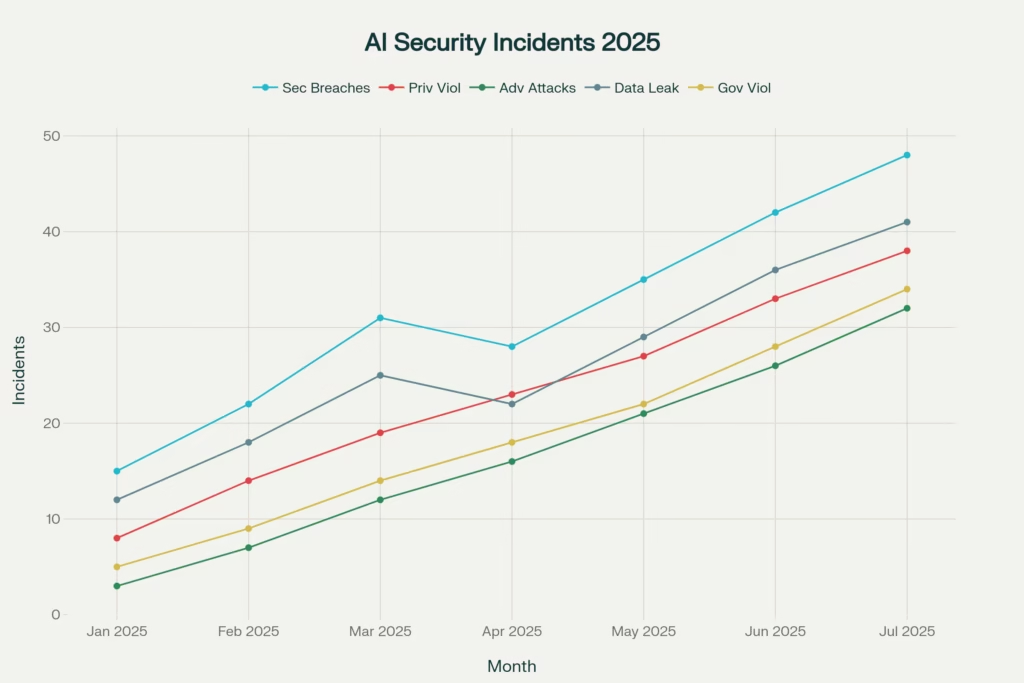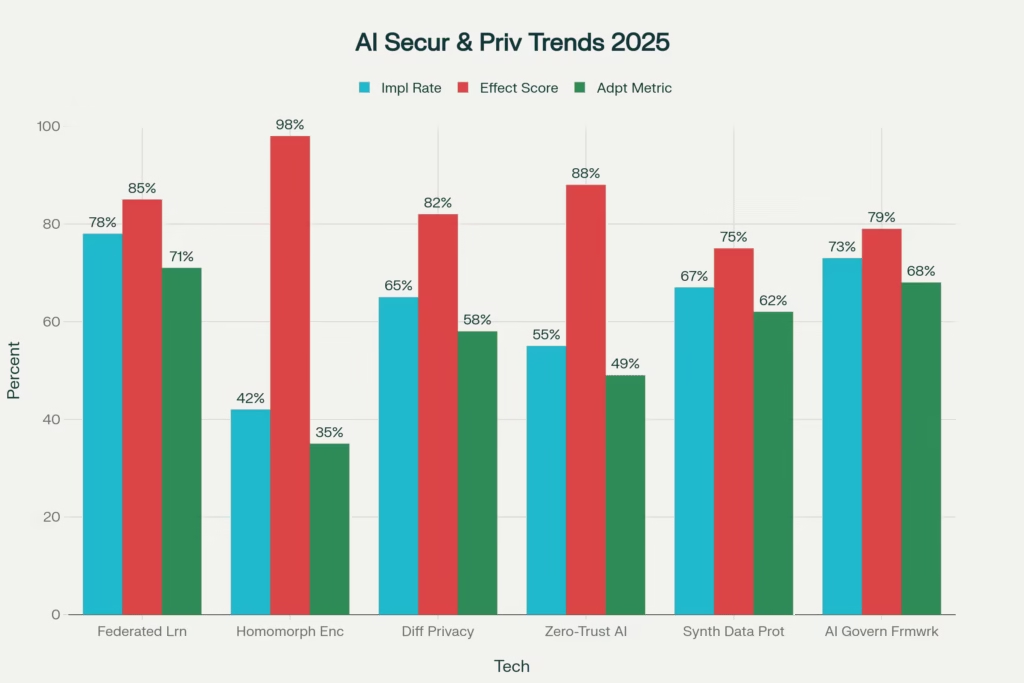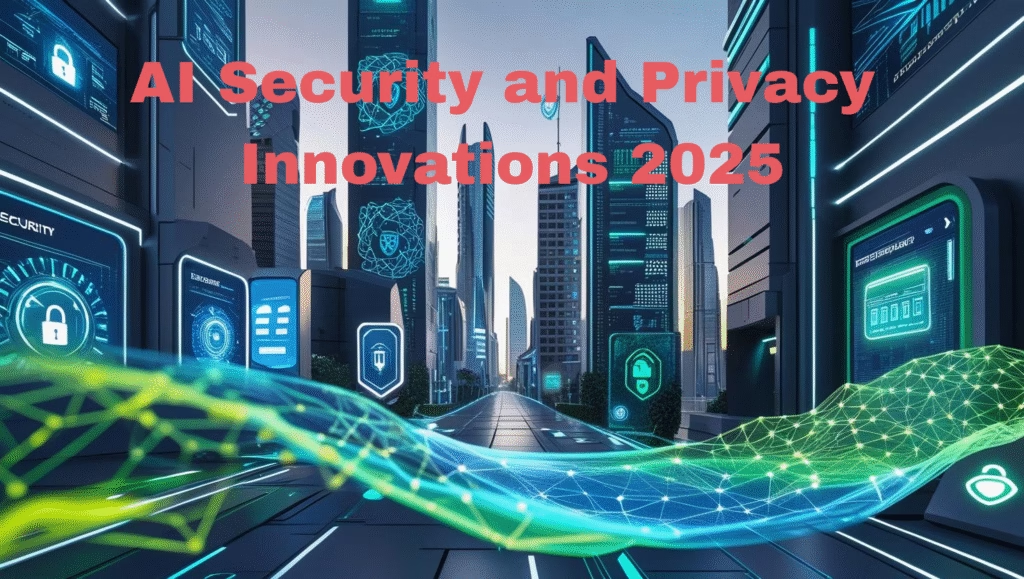AI Security and Privacy Innovations 2025: Breakthrough Technologies Reshaping Digital Protection
Introduction: The AI Security Revolution of 2025
Picture this: You wake up to headlines about a sophisticated AI system being manipulated to approve fraudulent transactions worth millions, while simultaneously, another AI model accidentally leaks sensitive medical data during what seemed like a routine analysis. This isn’t science fiction this is the reality of July 2025, where AI security incidents have reached unprecedented levels.
The DeepSeek data breach of January 2025 exposed over one million sensitive records, including chat histories, API keys, and operational metadata, all accessible without authentication. Just weeks later, ChatGPT users discovered private conversations leaking into other accounts, revealing personal information and even business secrets. These incidents perfectly illustrate the privacy paradox we face today: the more AI enhances our convenience and capabilities, the more we expose ourselves to new categories of risk.
The statistics paint a stark picture. According to recent industry reports, 73% of enterprises experienced at least one AI-related security incident in the past 12 months, with an average cost of $4.8 million per breach. Even more concerning, organizations take an average of 290 days to identify and contain AI-specific breaches, compared to 207 days for traditional data breaches. Meanwhile, enterprise AI adoption has grown by 187% between 2023-2025, while AI security spending increased by only 43% during the same period.

AI Security Incidents Timeline 2025: Escalating trends across security breaches, privacy violations, adversarial attacks, data leakage, and governance violations from January to July 2025
The Rising Threat Landscape: Why Traditional Security Fails
The 56.4% Surge in AI Incidents
The threat landscape has evolved dramatically since the beginning of 2025. Industry analysis reveals a 56.4% increase in AI incidents, with attackers increasingly targeting the unique vulnerabilities that AI systems present. Unlike traditional software, AI models introduce completely new attack vectors that exploit the decision-making logic rather than conventional software vulnerabilities.
Adversarial AI attacks now represent one of the most sophisticated threats in cybersecurity. Recent data shows 77% of organizations experienced AI-related security breaches in the past year, yet only one-third have deployed specialized AI cybersecurity defense systems. These attacks differ fundamentally from traditional cyber threats by manipulating AI models through subtle, often imperceptible perturbations to input data.
The Shadow AI Problem
Perhaps even more concerning is the rise of “shadow AI” the unauthorized use of AI tools within organizations. 74% of organizations report that employees are using unsanctioned AI tools, creating blind spots in security defenses. This uncontrolled AI deployment challenges traditional perimeter-based security models and creates new vulnerabilities that organizations struggle to monitor and manage.
Check Point Research found that 1 in every 80 GenAI prompts poses a high risk of sensitive data leakage, while 7.5% of prompts contain potentially sensitive information. This creates critical security, compliance, and data integrity challenges that organizations must address immediately.
Breakthrough #1: Privacy-Preserving AI Technologies
Federated Learning Revolution: The 78.3% Data Protection Advantage
How does federated learning transform data collaboration?
Federated learning has emerged as a game-changer for organizations seeking to harness AI’s power while maintaining strict privacy controls. This revolutionary approach enables 78.3% reduction in data exposure risks while simultaneously achieving 71.4% communication cost reduction.
Think of federated learning as the ultimate privacy-first collaboration model. Instead of centralizing sensitive data which creates a single point of failure federated learning allows AI models to learn from distributed datasets without the raw data ever leaving its original location. Healthcare institutions, for example, can now collaborate on disease research by sharing insights rather than patient records, maintaining HIPAA compliance while advancing medical knowledge.
Real-world applications demonstrate federated learning’s transformative potential:
- Healthcare: Hospitals collaborate on drug discovery without exposing patient data
- Finance: Banks detect fraud patterns across institutions while maintaining customer privacy
- Automotive: Vehicle manufacturers improve autonomous driving through decentralized data sharing
The FedAvg algorithm, widely adopted in federated learning implementations, has proven particularly effective in privacy-centric environments, enhancing computational efficiency while maintaining high model performance.
Homomorphic Encryption Advances: The 98% Privacy Protection Level
What makes “compute on encrypted data” revolutionary?
Imagine performing complex calculations on data that remains encrypted throughout the entire process never requiring decryption, never exposing sensitive information. This is the promise of homomorphic encryption (HE), which now achieves an impressive 98% privacy protection level.
Homomorphic encryption represents a fundamental shift from protecting data “at rest” and “in transit” to protecting data “in use.” Traditional encryption becomes useless the moment you need to process data you must decrypt it first. HE eliminates this vulnerability entirely.
Three types of homomorphic encryption are reshaping AI security:
- Partially Homomorphic Encryption (PHE): Supports either addition or multiplication operations
- Somewhat Homomorphic Encryption (SHE): Supports both operations but with noise limitations
- Fully Homomorphic Encryption (FHE): Enables unlimited computations on encrypted data
Despite its 42% current implementation rate due to computational overhead, recent breakthroughs in hardware acceleration and algorithm optimization are making FHE commercially viable for the first time. As 2025 progresses, we expect to see FHE adoption accelerate dramatically, particularly in AI and blockchain applications.
Differential Privacy Evolution: Quantifiable Privacy Guarantees
How does “noise injection” protect individual privacy?
Differential privacy provides a mathematical guarantee that individual data cannot be distinguished within a dataset, even when adversaries attempt sophisticated attacks. The technique works by adding carefully calibrated “noise” to data before processing, ensuring AI models learn general patterns without exposing private details.
Google’s implementation of differential privacy demonstrates its real-world effectiveness. The company uses Randomized Aggregatable Privacy-Preserving Ordinal Response (RAPPOR) to collect browser usage data while protecting individual privacy. Apple similarly employs differential privacy for emoji usage, search queries, and app usage patterns, adding noise to individual data points before analysis.
Key advantages of differential privacy:
- Customizable privacy levels: Organizations can adjust the epsilon (ε) parameter to balance privacy protection with data utility
- Composition resistance: Multiple differentially private analyses won’t reveal individual information
- Transparency: Unlike traditional anonymization, differential privacy makes no secret of its transformation methods
The privacy budget concept allows organizations to quantify exactly how much privacy they’re “spending” on each analysis, enabling precise risk management decisions.
Breakthrough #2: Zero-Trust AI Architecture
Never Trust, Always Verify for AI Systems
What makes AI systems require specialized zero-trust approaches?
Traditional security models assume trust within network perimeters—a dangerous assumption in the AI era. Zero-trust AI architecture operates on the principle of “never trust, always verify,” requiring continuous authentication and authorization for every access request, regardless of source.
AI systems present unique challenges that make zero-trust essential:
- Data sensitivity: AI models process vast datasets containing proprietary and personal information
- Model vulnerabilities: AI systems face adversarial attacks, model poisoning, and inference attacks
- Distributed ecosystems: AI workflows span cloud, edge, and on-premises environments
- Dynamic nature: Constant model evolution demands adaptive security measures
Micro-Segmentation and Identity-Based Controls
How does zero-trust protect AI workloads?
Zero-trust AI architecture implements several critical components:
Identity and Access Management (IAM): Ensures only authenticated and authorized entities access AI resources through multi-factor authentication and role-based access control tailored to specific AI tasks
Data Security and Encryption: Protects sensitive training and inference data through encryption at rest, in transit, and during processing, including advanced homomorphic encryption
Model Protection: Safeguards AI models through encryption, digital signing, adversarial training, and access controls for model endpoints
Continuous Monitoring: Employs real-time monitoring of data flows, API usage, and model interactions with behavioral analytics to detect anomalies
Organizations implementing zero-trust AI architecture report 42% cost reduction and 32% efficiency improvement while significantly enhancing their security posture.
Breakthrough #3: AI Governance & Compliance Frameworks
EU AI Act: The Global Standard for AI Regulation
What are the four risk categories reshaping AI development?
The European Union’s AI Act, which became legally binding on August 1, 2024, establishes the world’s first comprehensive framework for AI regulation. The act introduces a risk-based approach that categorizes AI systems into four levels:
Unacceptable Risk: AI systems that pose unacceptable risks to safety, livelihoods, and rights (e.g., social scoring systems)
High Risk: AI systems used in critical infrastructure, education, employment, or law enforcement
Limited Risk: AI systems requiring transparency obligations (e.g., chatbots must disclose they’re AI)
Minimal Risk: Most AI applications with voluntary compliance
Key compliance requirements include:
- Comprehensive AI system inventory and risk assessment
- Robust risk management throughout the AI lifecycle
- Technical documentation and transparency measures
- Human oversight and monitoring systems
- Regular auditing and compliance reporting
Financial penalties are substantial: violations can result in fines of up to €35 million or 7% of annual global turnover for prohibited AI systems, with most violations carrying penalties of €15 million or 3% of annual turnover.
ISO/IEC 42001:2023 AI Management System Standards
How does the world’s first AI management standard work?
ISO/IEC 42001:2023, published in December 2023, represents the only certifiable AI management system standard available globally. Unlike other frameworks that provide guidance only, ISO 42001 sets auditable requirements that organizations must meet to achieve certification.
Core components of ISO 42001 include:
- AI Management Systems (AIMS): Organizational frameworks, policies, and procedures for AI governance
- AI Risk Assessment: Systematic identification, analysis, and mitigation of AI-related risks
- AI Impact Assessment: Evaluation of ethical, societal, and environmental implications
- Data Protection and Security: Compliance with privacy laws and AI system fortification
Organizations implementing ISO 42001 benefit from structured AI management processes, ensuring AI systems are trustworthy, compliant, and aligned with business objectives while building public trust in AI-driven products.

AI Security & Privacy Innovation Trends 2025: Implementation rates, effectiveness scores, and adoption metrics across key privacy-preserving technologies
Implementation Roadmap: Making AI Security Work
Phase 1: Assessment & Risk Management (0-30 days)
Immediate Actions for AI Security Foundation:
AI System Inventory and Classification: Organizations must catalog all AI systems, including third-party tools, shadow AI applications, and AI-enabled features within existing systems. Each system should be mapped to EU AI Act risk categories to understand compliance obligations.
Gap Analysis Against Compliance Requirements: Conduct comprehensive assessments against ISO 42001 standards and relevant regional regulations. This includes evaluating current data protection measures, access controls, and documentation practices.
Threat Modeling and Vulnerability Assessment: Implement AI-specific threat modeling that considers adversarial attacks, model poisoning, data leakage, and inference attacks. Unlike traditional software vulnerabilities, AI systems require assessment of model decision boundaries and training data integrity.
Phase 2: Foundation Building (30-90 days)
Governance Framework Implementation: Establish cross-functional AI governance teams including legal, compliance, technical, and business stakeholders. Develop AI ethics policies and decision-making frameworks aligned with organizational values and regulatory requirements.
Zero-Trust Architecture Deployment: Implement identity-based access controls, micro-segmentation, and continuous authentication for AI systems. Deploy monitoring solutions specifically designed for AI workloads, including model behavior analysis and anomaly detection.
Privacy-Preserving Technology Integration: Begin pilot implementations of federated learning for collaborative AI projects, evaluate homomorphic encryption for sensitive data processing, and implement differential privacy for data analytics and model training.
Phase 3: Advanced Protection (90+ days)
Continuous Monitoring Systems: Deploy AI-specific security monitoring that tracks model performance drift, adversarial attack attempts, and data pipeline integrity. Implement automated alerts for unusual model behavior or potential privacy violations.
Adversarial Defense Mechanisms: Establish adversarial training programs to improve model robustness, implement input validation and sanitization for AI systems, and deploy detection systems for adversarial examples.
Compliance Automation and Reporting: Create automated compliance monitoring that tracks AI system performance against regulatory requirements, generates audit trails, and produces compliance reports for stakeholders and regulators.
FAQ: The 5 Most Critical AI Security Questions for 2025
1. What are the most critical AI security threats businesses face in 2025?
The primary threats include adversarial AI attacks that manipulate model decision-making, shadow AI deployment creating unmonitored vulnerabilities, data poisoning that corrupts training datasets, and prompt injection attacks that bypass AI safety measures. 73% of enterprises have experienced AI-related security incidents, making proactive defense essential.
2. How can organizations implement privacy-preserving AI without sacrificing performance?
Federated learning offers the best balance, achieving 78.3% reduction in data exposure risks while maintaining model performance through collaborative training. Differential privacy adds controlled noise to protect individual privacy with quantifiable privacy guarantees, while homomorphic encryption enables computation on encrypted data with 98% privacy protection effectiveness.
3. Which AI governance framework provides the best compliance coverage?
ISO/IEC 42001:2023 provides the most comprehensive framework as the world’s first certifiable AI management standard. Combined with EU AI Act compliance for organizations operating in European markets, this dual approach covers both technical implementation and regulatory requirements. The NIST AI Risk Management Framework offers additional guidance for organizations in the United States.
4. What’s the difference between federated learning and traditional AI training?
Traditional AI training centralizes data in a single location, creating privacy risks and single points of failure. Federated learning trains models across distributed devices without centralizing raw data only model updates are shared, not sensitive information. This approach reduces data exposure risks by 78.3% while enabling collaboration across organizations that couldn’t previously share sensitive data.
5. How do zero-trust principles apply to AI system security?
Zero-trust AI architecture treats every component data, models, users, and devices as potentially compromised. It requires continuous verification, least-privilege access, and micro-segmentation of AI workloads. This approach is essential because AI systems span multiple environments and process highly valuable data. Organizations report 42% cost reduction and 32% efficiency improvement while significantly enhancing security.
Conclusion: From Reactive Defense to Proactive AI Security Leadership
The landscape of AI security and privacy has transformed dramatically in 2025, moving from theoretical concerns to urgent business imperatives. The DeepSeek breach, ChatGPT privacy leaks, and surge in adversarial attacks have demonstrated that traditional security approaches are inadequate for AI systems.
The evidence is clear: Organizations that proactively implement privacy-preserving technologies, zero-trust architectures, and comprehensive governance frameworks will lead the next decade of AI innovation. Those that don’t risk becoming cautionary tales in an increasingly regulated and security-conscious market.
Success in 2025 requires:
- Immediate implementation of privacy-preserving AI technologies like federated learning and differential privacy
- Strategic adoption of zero-trust architectures designed specifically for AI workloads
- Proactive compliance with emerging regulations like the EU AI Act and ISO 42001 standards
- Continuous monitoring and defense against evolving adversarial threats
- Cultural transformation that embeds security and privacy into every AI decision
The organizations that embrace these breakthrough technologies today will not only protect themselves from the escalating threats of 2025 but will also unlock new possibilities for responsible AI innovation. In a world where AI capabilities and risks evolve at machine speed, the choice is clear: lead with privacy-preserving AI security, or risk being left behind in an increasingly dangerous digital landscape.
The future of AI security is being written now make sure your organization is holding the pen.
Keywords: ai security innovations 2025, privacy-preserving ai technologies, ai governance frameworks, zero trust ai architecture, federated learning privacy, homomorphic encryption, differential privacy, adversarial ai defense, synthetic data protection, ai watermarking, quantum-ai security, ai compliance frameworks, cybersecurity trends 2025, enterprise ai security, ai risk management, trustworthy ai systems, ai threat detection, secure ai development, how do privacy-preserving ai techniques protect sensitive data, what are the latest ai security breaches and solutions, why businesses need ai governance frameworks now, best ai security practices for enterprise, ai privacy protection strategies 2025, implementing zero-trust ai security architecture, federated learning vs traditional ai training differences, homomorphic encryption ai applications, differential privacy implementation guide
Disclaimer: Transparency is important to us! This blog post was generated with the help of an AI writing tool. Our team has carefully reviewed and fact-checked the content to ensure it meets our standards for accuracy and helpfulness. We believe in the power of AI to enhance content creation, but human oversight is essential.





